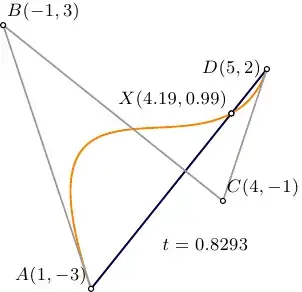Suppose that two ends of a cubic Bezier curve is connected by a straight line. Is there a simple way to find out whether this straight line intersects the Bezier curve (apart from the endpoints)? If it intersects then what will be the corresponding Bezier curve parameter's value?
2 Answers
Given 2D cubic Bezier segment $\mathcal{B}(t,A,B,C,D)=A\,(1-t)^3+3B\,(1-t)^2t+3C\,(1-t)t^2+D\,t^3$, $t\in[0,1]$ and line segment $\mathcal{L}(t,A,D)=A\,(1-s)+D\,s$, $s\in[0,1]$, the value of $t:\mathcal{B}(t,A,B,C,D)=\mathcal{L}(s,A,D),\ t\ne0, t\ne1$ is the same as the value of $t:\mathcal{B}(t,0,B-A,C-A,D-A)=\mathcal{L}(s,0,D-A)$. So, with a substitution $b=B-A,\ c=C-A,\ d=D-A$ we can solve a system of two equations with two unknowns $t,s$:
\begin{align} \mathcal{B}(t,0,b_x,c_x,d_x) &= \mathcal{L}(s,0,d_x) \\ \mathcal{B}(t,0,b_y,c_y,d_y) &= \mathcal{L}(s,0,d_y) \end{align}
which gives the value of parameter $t$ as
\begin{align} t &= \frac{b_x\,d_y-d_x\,b_y}{b_x\,d_y-c_x\,d_y-d_x\,b_y+d_x\,c_y} \end{align}
If $0<t<1$ than the intersection point of $\mathcal{B}$ and $\mathcal{L}$ is $X=\mathcal{B}(t,A,B,C,D)$.

- 13,581
-
It is very explanatory and convincing, thanks. For a perfection I would like to propose a little algebraic correction: The line segment should be L(t,A,D). – John Railman Jun 24 '15 at 18:50
-
@John Railman: Of course it is $AD$, great thanks for pointing this, fixed. – g.kov Jun 24 '15 at 18:59
I just wanted to add to g.kov's good derivation, that the $t$ value is the parameter for the Bézier segment, not the line, so the range of $0 < t < 1$ stated above doesn't guarantee the the intersection is on the line segment between A and D, only that it is on the Bézier segment. The intersection could fall outside of the line segment, as pictured:
https://i.stack.imgur.com/ER2SH.png
Following the same substitution as above, $s$ can be derived as:
$$ s = \frac{\left(b_y d_x-b_x d_y\right) \left(d_x \left(3 b_x c_y^2-3 b_y c_x c_y-2 b_x b_y d_y\right)+d_y \left(-3 b_x c_x c_y+3 b_y c_x^2+b_x^2 d_y\right)+b_y^2 d_x^2\right)}{\left(d_x \left(b_y-c_y\right)+d_y \left(c_x-b_x\right)\right){}^3} $$
Only when both $0 < s < 1$ and $0 < t < 1$ is there point of intersection between the curve and line segment.
- 53